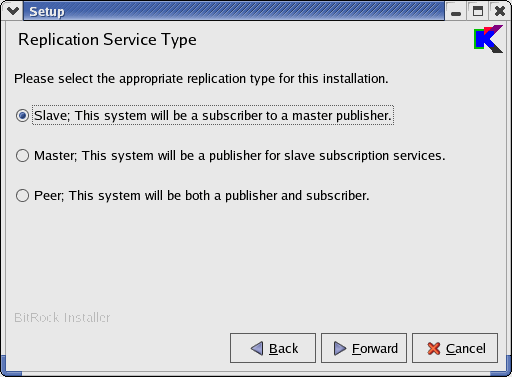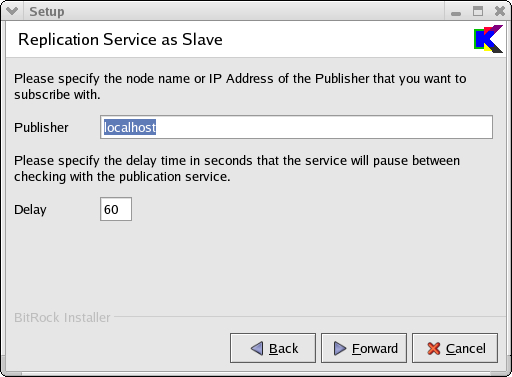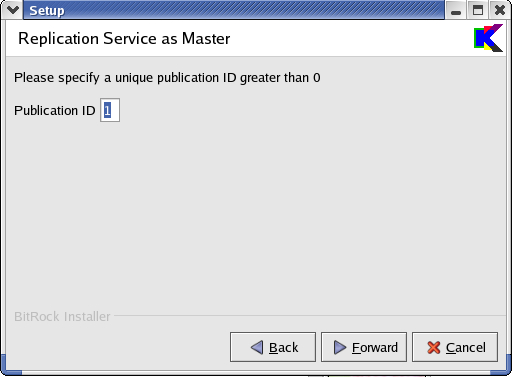Difference between revisions of "Recital Replication Graphical Installation"
Yvonnemilne (Talk | contribs) |
Yvonnemilne (Talk | contribs) |
||
| (20 intermediate revisions by 2 users not shown) | |||
| Line 5: | Line 5: | ||
| − | The first thing you must specify is what type of Replication Service you will be running on each server | + | The first thing you must specify is what type of Replication Service you will be running on each server. |
| − | * '''Slave''' - Select this type if this system will be a slave subscriber | + | * '''Slave''' - Select this type if this system will be a slave subscriber. There can be many slave subscribers but updates will only be performed from data published by the replication service. |
| − | * '''Master''' - Select this type if this system will be the master publisher | + | * '''Master''' - Select this type if this system will be the master publisher. There can be only one master publisher and only updates on this system will be published for replication. |
| − | + | ||
== Slave == | == Slave == | ||
| + | |||
[[Image:RRS_Install_Replication_Slave_Options.jpg]] | [[Image:RRS_Install_Replication_Slave_Options.jpg]] | ||
| Line 24: | Line 24: | ||
== Master == | == Master == | ||
| + | |||
[[Image:RRS_Install_Replication_Master_Publication_ID.jpg]] | [[Image:RRS_Install_Replication_Master_Publication_ID.jpg]] | ||
| Line 30: | Line 31: | ||
The publication ID is a unique number that is used to differentiate each system in the replication service. For a master publisher it should be set to a value of 1. This ID should not be changed once the replication service has been started on the system. | The publication ID is a unique number that is used to differentiate each system in the replication service. For a master publisher it should be set to a value of 1. This ID should not be changed once the replication service has been started on the system. | ||
| − | |||
| − | |||
| − | |||
| − | |||
| − | |||
| − | |||
| − | |||
| − | |||
| − | |||
| − | |||
| − | |||
| − | |||
| − | |||
| − | |||
| − | |||
| − | |||
| − | |||
| − | |||
| − | |||
| − | |||
== Modifying installed values == | == Modifying installed values == | ||
| Line 60: | Line 41: | ||
=== Configuration files === | === Configuration files === | ||
You can edit the configuration files and change the values manually. The following table contains all the variables defined during the installation process. The configuration file are stored in the ''conf'' directory which is in the root recital installation directory. | You can edit the configuration files and change the values manually. The following table contains all the variables defined during the installation process. The configuration file are stored in the ''conf'' directory which is in the root recital installation directory. | ||
| + | |||
{| class="bordered" | {| class="bordered" | ||
| Line 78: | Line 60: | ||
| DB_REPLOG | | DB_REPLOG | ||
| TRUE | | TRUE | ||
| − | | | + | | recital.conf |
|- | |- | ||
| DB_REPTYPE | | DB_REPTYPE | ||
| slave | | slave | ||
| − | | | + | | recital.conf |
|- | |- | ||
| DB_PUBLISHER | | DB_PUBLISHER | ||
| localhost | | localhost | ||
| − | | | + | | recital.conf |
|- | |- | ||
| DB_REPDELAY | | DB_REPDELAY | ||
| 60 | | 60 | ||
| − | | | + | | recital.conf |
|- | |- | ||
| − | |||
| − | |||
| − | |||
|} | |} | ||
<br> | <br> | ||
| − | |||
| − | |||
| − | |||
| − | |||
| − | |||
=== DB_REPLOG === | === DB_REPLOG === | ||
The variable DB_REPLOG is used to enable or disable logging on the replication services. A value of TRUE will enable logging and a value of FALSE will disable logging. By default log files will be stored in the log and/or debug directory located under to root recital installation directory. | The variable DB_REPLOG is used to enable or disable logging on the replication services. A value of TRUE will enable logging and a value of FALSE will disable logging. By default log files will be stored in the log and/or debug directory located under to root recital installation directory. | ||
| − | |||
== Replication Database == | == Replication Database == | ||
| − | During the installation process a database called ''replication'' will be created. A table called queue will also be created in the replication database. If this system is the master publisher | + | During the installation process a database called ''replication'' will be created. A table called ''queue'' will also be created in the replication database. If this system is the master publisher a table called ''subscribers'' will be created. |
| − | + | ||
| − | + | ||
| − | + | ||
| − | + | ||
| − | + | ||
| − | + | ||
| − | + | ||
| − | + | ||
| − | + | ||
| − | + | ||
| − | + | ||
| − | + | ||
| − | + | ||
| − | + | ||
| − | + | ||
| − | + | ||
| − | + | ||
| − | + | ||
| − | + | ||
| − | + | ||
| − | + | ||
| − | + | ||
| − | + | ||
| − | + | ||
| − | + | ||
| − | + | ||
| − | + | ||
| − | + | ||
| − | + | ||
| − | + | ||
[[Category:RRS Installation]] | [[Category:RRS Installation]] | ||
Latest revision as of 14:41, 8 June 2010
Contents
Replication Type
The first thing you must specify is what type of Replication Service you will be running on each server.
- Slave - Select this type if this system will be a slave subscriber. There can be many slave subscribers but updates will only be performed from data published by the replication service.
- Master - Select this type if this system will be the master publisher. There can be only one master publisher and only updates on this system will be published for replication.
Slave
Publisher
Specify the node name or IP Address of the Publisher that this slave will subscribe to. This should be the system that the Master replication service was installed on.
Delay
Specify the delay time in seconds that the service will pause between checking with the publication service.
Master
Publication ID
The publication ID is a unique number that is used to differentiate each system in the replication service. For a master publisher it should be set to a value of 1. This ID should not be changed once the replication service has been started on the system.
Modifying installed values
You can modify the values configured during installation by the following ways;
dbinstall rrs
Executing this command at the operating system prompt will allow you to reconfigure the replication service.
Configuration files
You can edit the configuration files and change the values manually. The following table contains all the variables defined during the installation process. The configuration file are stored in the conf directory which is in the root recital installation directory.
| Variable Name | Default Value | Configuration File |
|---|---|---|
| DB_PUBLICATIONID | 0 | recital.conf |
| DB_REPDIR | replication | recital.conf |
| DB_REPLOG | TRUE | recital.conf |
| DB_REPTYPE | slave | recital.conf |
| DB_PUBLISHER | localhost | recital.conf |
| DB_REPDELAY | 60 | recital.conf |
DB_REPLOG
The variable DB_REPLOG is used to enable or disable logging on the replication services. A value of TRUE will enable logging and a value of FALSE will disable logging. By default log files will be stored in the log and/or debug directory located under to root recital installation directory.
Replication Database
During the installation process a database called replication will be created. A table called queue will also be created in the replication database. If this system is the master publisher a table called subscribers will be created.


